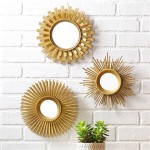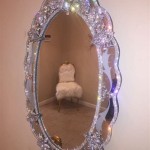Sears Bathroom Mirrors: A Reflective History and Contemporary Options
Sears, Roebuck and Co., a once-dominant force in American retail, held a significant presence in the home goods market, including bathroom furnishings. While the retail landscape has shifted dramatically, the legacy of Sears bathroom mirrors remains a topic of interest for homeowners seeking vintage pieces and those curious about the evolution of bathroom design.
From the early 20th century through the latter half, Sears catalogs served as primary sources for home decor inspiration and purchasing. Bathroom mirrors featured in these catalogs reflected the prevailing design trends of each era, offering a glimpse into the evolving aesthetics of American homes. These catalogs often showcased a range of mirror styles, from simple, functional designs to more ornate options incorporating decorative elements like etched glass or wooden frames.
The early Sears catalogs, particularly those from the pre-World War II era, frequently featured medicine cabinets with integrated mirrors. These combinations provided both functionality and style, offering a practical solution for storage in smaller bathrooms. The mirrors themselves were typically rectangular and framed with simple wood or metal, often featuring a beveled edge. The emphasis was on practicality and affordability, reflecting the needs and priorities of the time.
As the mid-century modern aesthetic gained popularity, Sears bathroom mirrors began to reflect this shift. Simpler lines, geometric shapes, and the use of materials like chrome and plastic became prominent features. Larger mirrors, extending beyond the confines of the medicine cabinet, started to appear in catalogs, reflecting an increasing focus on creating a more spacious and stylish bathroom environment.
The latter half of the 20th century saw a diversification of styles offered by Sears. Hollywood-style lighted mirrors, often featuring multiple bulbs around the perimeter, emerged as a popular choice. These mirrors provided enhanced illumination for grooming tasks and added a touch of glamour to the bathroom. Framed mirrors, incorporating materials like brass, gold, and even bamboo, offered homeowners a wider range of choices to complement their individual bathroom décor.
Vintage Sears bathroom mirrors have become sought-after items for collectors and individuals seeking to add a touch of retro charm to their homes. These mirrors can be found at antique stores, flea markets, and online marketplaces. Identifying an authentic Sears mirror might involve examining the back for manufacturer markings or comparing the mirror to images from vintage Sears catalogs. The condition of the mirror, the presence of original hardware, and the rarity of the design can influence the value of these vintage pieces.
While the Sears retail landscape has drastically changed, the demand for bathroom mirrors remains consistent. Contemporary retailers now offer a vast array of options, often drawing inspiration from past design trends while incorporating modern materials and technologies. Frameless mirrors, LED-lighted mirrors, and mirrors with integrated anti-fog technology represent some of the contemporary advancements in bathroom mirror design.
When selecting a bathroom mirror, factors such as size, shape, style, and functionality should be considered. The dimensions of the bathroom, the existing décor, and the intended use of the mirror will influence the appropriate choice. A larger mirror can create the illusion of more space in a smaller bathroom, while a smaller, more decorative mirror might be suitable as a secondary element above a vanity.
The shape of the mirror can also contribute to the overall aesthetic. Round or oval mirrors can soften the lines of a bathroom dominated by rectangular fixtures, while rectangular or square mirrors can maintain a sense of symmetry and order.
The style of the mirror should complement the overall design of the bathroom. A sleek, frameless mirror might be suitable for a modern minimalist bathroom, while a more ornate framed mirror might be appropriate for a traditional or vintage-inspired space.
Functionality is another key consideration. Mirrors with integrated lighting, magnification, or anti-fog features can enhance the usability of the mirror, particularly for tasks like applying makeup or shaving.
The evolution of Sears bathroom mirrors provides a fascinating reflection of changing design trends throughout the 20th century. From the practical medicine cabinets of the early years to the stylish lighted mirrors of later decades, Sears catered to the evolving needs and aesthetic preferences of American homeowners. While the company's retail presence has diminished, the legacy of Sears bathroom mirrors continues to influence contemporary design and remains a subject of interest for collectors and history enthusiasts alike.

7870 Sears Road Horton Mi 49246 9513 Home For Mls 23128209 Real Estate One

50 Charming Fabulous Bathroom Mirror Designs 2024 Mirrors Diy Design Lights

24 In W X 32 H Rectangular Frameless Wall Led Mirror Bathroom Vanity Gm 861 The Home Depot

Flynama 24 In W X 36 H Rectangular Waterproof Backlit Frameless Anti Fog Led Bathroom Vanity Mirror White Xyd Hc Em003 The Home Depot

24 In W X 30 H Black Rectangular Aluminum Led Medicine Cabinet With Mirror And Adjustable Shelf Right Open Yx 325 The Home Depot

How To Build A Wood Frame Around Bathroom Mirror Young House Love

Shannon Sears Mcilwain On Instagram Working A Few Master Bathrooms Which Are Always So Fun Loving Th Basement Bathroom Framed Mirror

Pretty In Porcelain Contemporary Bathroom Nashville By Terri Sears Kitchen And Bath Desi Design Trends Vanity

How To Build A Wood Frame Around Bathroom Mirror Young House Love








